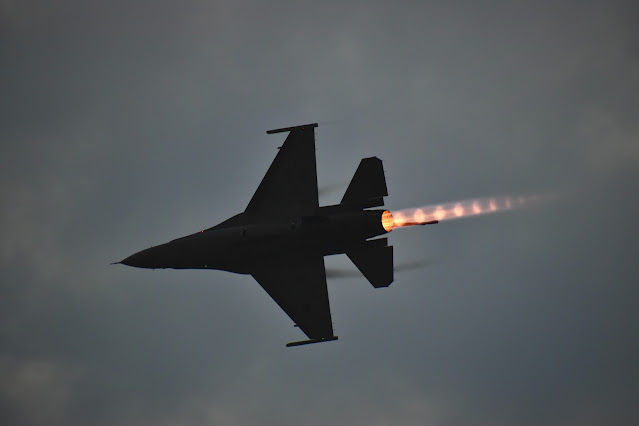Introduction
The Air Force Test Center at Edwards Air Force Base in California conducted its first test flight of an F-16 modified with AI technology for the first time on July 28. The modified fighter jet is currently used by the Air Force Test Center to demonstrate how autonomous systems are integrated into existing warplanes such as Boeing 737s and Lockheed Martin F-22s. As well as creating new challenges for pilots and engineers, autonomous technology could potentially lead to better aircraft designs that require less maintenance work over their lifetimes.
Modified F-16 Fighter Jet Completes 'Stunning' AI-Controlled Test Fly for the First Time in History
The modified F-16 was piloted by an Air Force test pilot and followed a preprogrammed flight plan. The mission involved navigation, attitude control, flight termination and autonomous landing.
According to the Air Force Research Laboratory (AFRL), this is the first time that an AI-controlled aircraft has been flown in such a manner without human intervention.
The test flight took place on July 28th at Edwards Air Force Base in California as part of Project Maven—a program run by AFRL that aims to develop better ways for computers and robots to identify threats from enemy forces or other objects at night time when visibility is low due to clouds or foggy conditions
The modified F-16 has been tested under AI control for the first time, proving that it could be used in future air force maneuvers.
AI technology enables Bolt to make adjustments in relation to changes in its environment, such as changing weather conditions or wind direction. During the test flight, Bolt was piloted by an engineer who was able to take control of the aircraft if necessary.
The aircraft's flight controls were also programmed with AI algorithms that allowed them to be more responsive than usual. For example, when flying over water at low altitude (below 500 feet), the pilot could choose whether or not he wanted his aircraft to fly through it instead of around it by selecting "swim" mode on his control panel."
The modified F-16, known as "Bolt," is operated by the Air Force Test Center at Edwards Air Force Base in California.
The modified F-16, known as "Bolt," is operated by the Air Force Test Center at Edwards Air Force Base in California. It was used to test new technologies and autonomous systems that could be applied in future combat aircraft.
The jet has been modified with sensors, cameras and other equipment so it can fly autonomously while carrying out missions such as reconnaissance or ground attack missions.
The test flight was conducted on July 28 and demonstrated the ability of the modified jet to fly autonomously without human intervention.
The test flight was conducted on July 28 and demonstrated the ability of the modified jet to fly autonomously without human intervention.
AI technology enables Bolt to make adjustments in relation to changes in its environment, such as changing weather conditions or wind direction.
Bolt is an F-16 that has been modified with sensors that allow it to plan its own flight path based on real data from other aircrafts' flight paths (known as "situational awareness").
AI technology enables Bolt to make adjustments in relation to changes in its environment, such as changing weather conditions or wind direction.
The modified F-16, known as "Bolt," is operated by the Air Force Test Center at Edwards Air Force Base in California. AI technology enables Bolt to make adjustments in relation to changes in its environment, such as changing weather conditions or wind direction.
The AI system has been trained on data of previous flights and can calculate where it should fly next based on information from those flights. This allows Bolt's pilots to finish their missions without having to rely on an external human controller who could be distracted by other duties during their mission time frame (or even worse—away).
During the test flight, Bolt was piloted by an engineer who was able to take control of the aircraft if necessary.
The test flight was conducted on July 28, 2019 and is the first time in history that an F-16 aircraft has been flown by an AI-controlled pilot.
The modified F-16, known as "Bolt," is operated by the Air Force Test Center at Edwards Air Force Base in California. During this test flight, Bolt was piloted by an engineer who was able to take control of the aircraft if necessary.
The experiment takes place every three years and demonstrates how autonomous systems are integrated into existing warplanes such as Boeing 737s and Lockheed Martin F-22s. As well as creating new challenges for pilots and engineers, autonomous technology could potentially lead to better aircraft designs that require less maintenance work over their lifetimes.
The test flight was conducted on July 28 and demonstrated the ability of the modified jet to fly autonomously without human intervention. The modified F-16, known as "Bolt," is operated by the Air Force Test Center at Edwards Air Force Base in California.
The AI-controlled test flight comes after successful tests were completed earlier this year by other F-16s in which they were used as flying sensors that could detect enemy aircraft or missiles using their radars and cameras (see related story).
Conclusion
The F-16 is currently the most widely used fighter jet in history. With more than 4,000 units in service around the world and over 6,000 more on order, it's clear that this aircraft has a lot of potential for further development.









Social Plugin